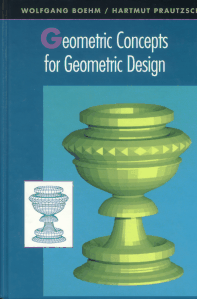
Last update, March 30, 2004
Publications by Prof., Dr. Wolfgang Boehm et al.
Work: Technische Universität Braunschweig, Applied Geometry &
Computer Graphics, Germany
Home: Reitlingweg 14, D-38302, Wolfenbüttel, Germany
BibTeX references.

Hartmut
Prautzsch, Wolfgang Boehm, Marco Paluszny
315 pages, Springer, 2002
Mathematics and Visualization Series
ISBN: 3-540-43761-4
I Curves
1. Geometric fundamentals
2. Bézier representation
3. Bézier techniques
4. Interpolation and approximation
5. B-Spline representation
6. B-spline techniques
7. Smooth curves
8. Uniform subdivision
II Surfaces
9. Tensor Product Surfaces
10. Bézier representation of triangular patches
11.Bézier techniques for triangular patches
12. Interpolation
13. Constructing smooth surfaces
14. G k - Constructions
15. Stationary subdivision for regular nets
16. Stationary subdivision for arbitrary nets
III. Multivariate Splines
17. Box Splines
18. Simplex splines
19. Multivariate Splines.
W. Boehm, J. Hoschek and H.-P. Seidel
In M. Artin, H. Kraft & R. Remmert, editors, Duration and Change -
Fifty Years at Oberwolfach, pp.106-138. Springer-Verlag, 1994.
Available on-line.
Computer Aided Geometric Design (CAGD) is concerned with the design, computation, and representation of curved objects on a computer. Therefore, not surprisingly, CAGD has traditionally had strong ties to some classical mathematical disciplines such as approximation theory (approximation by polynomial and piecewise polynomial functions), differential geometry (parametric surfaces), algebraic geometry (algebraic surfaces), functional analysis and differential equations (surface design by minimizing functionals), and numerical analysis. In addition, work in CAGD also requires a solid background in computer science.

Wolfgang Boehm & Hartmut Prautzsch
Wellesley, Mass., USA: A.K. Peters, 1994, 424 pages.
URLs:
"Often, a solution to a problem lies simply in finding its correct description. It is this underlying concept that consolidates the text of this unique and lively survey of geometric ideas. The authors provide a way to visualize a variety of geometric problems and present the tools for their accurate representation. Disassociating fundamental ideas and methods from special applications, they clarify these concepts for the reader and allow him to apply the material to other problems of a geometric nature. Relying on the idea that a picture "is worth a thousand words," the text is beautifully illustrated with figures and diagrams. Anyone attracted to or wishing to gain a deeper understanding of the beauty of geometric mysteries will find this book engaging and invaluable."
Wolfgang Boehm
Computer Aided Geometric Design (CAGD), v.7, pp.243-255, 1990.
Page created & maintained by Frederic F. Leymarie,
1998-2004.
Comments, suggestions, etc., mail to: leymarie@lems.brown.edu